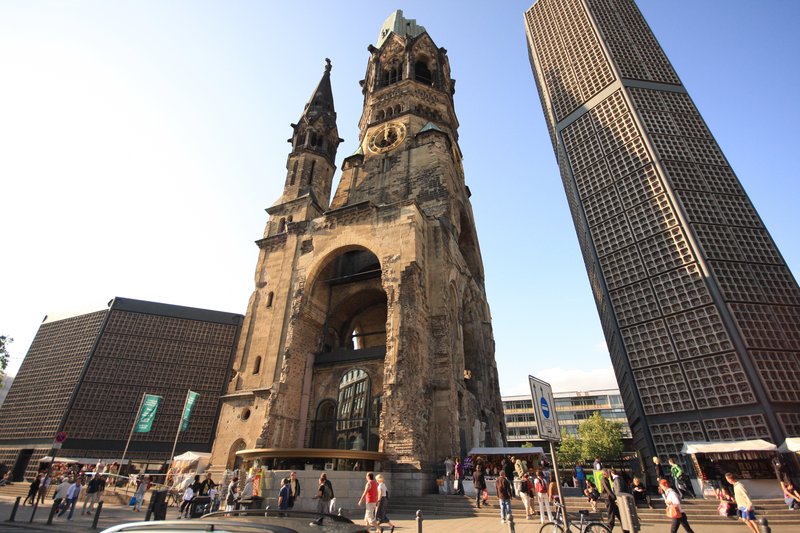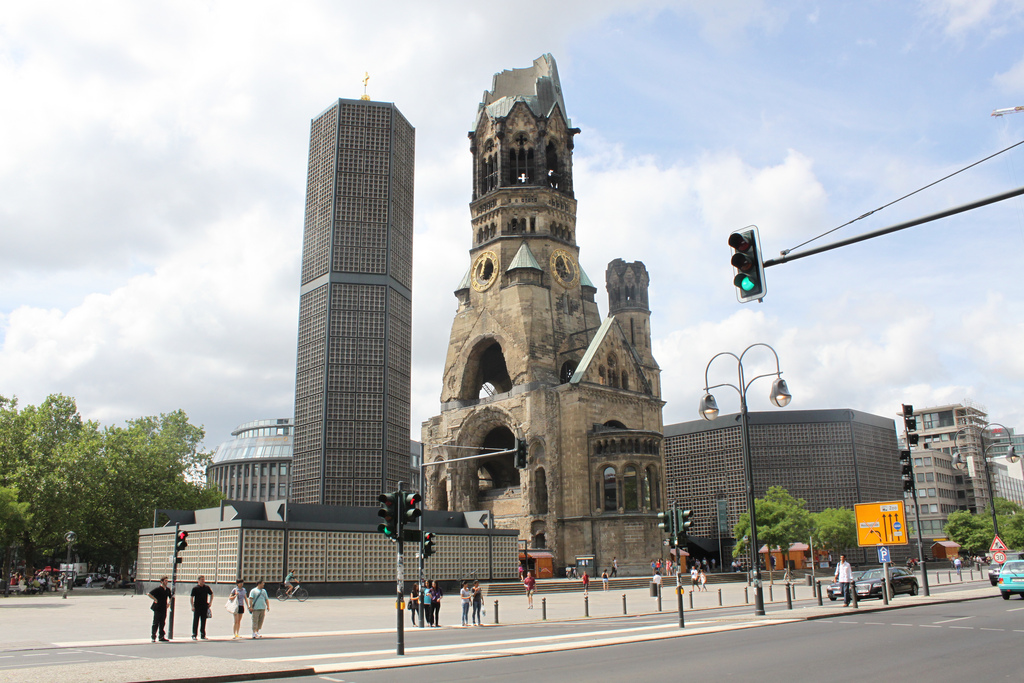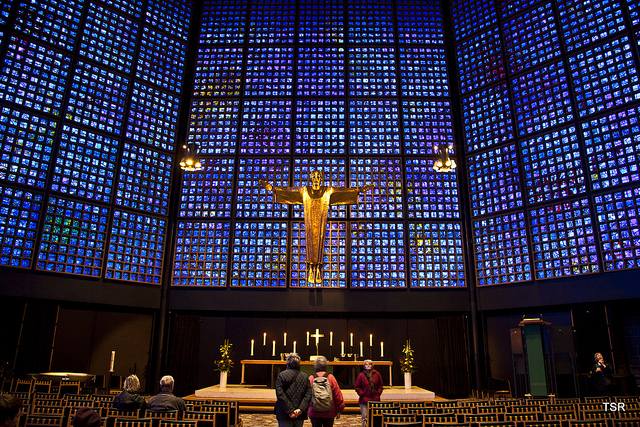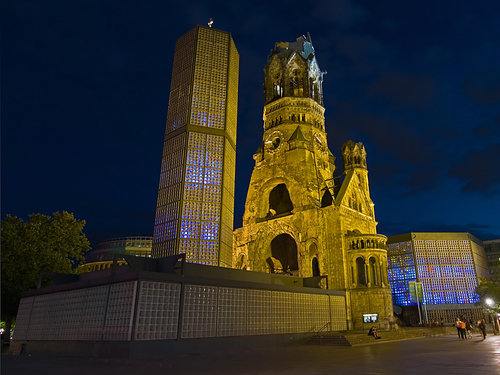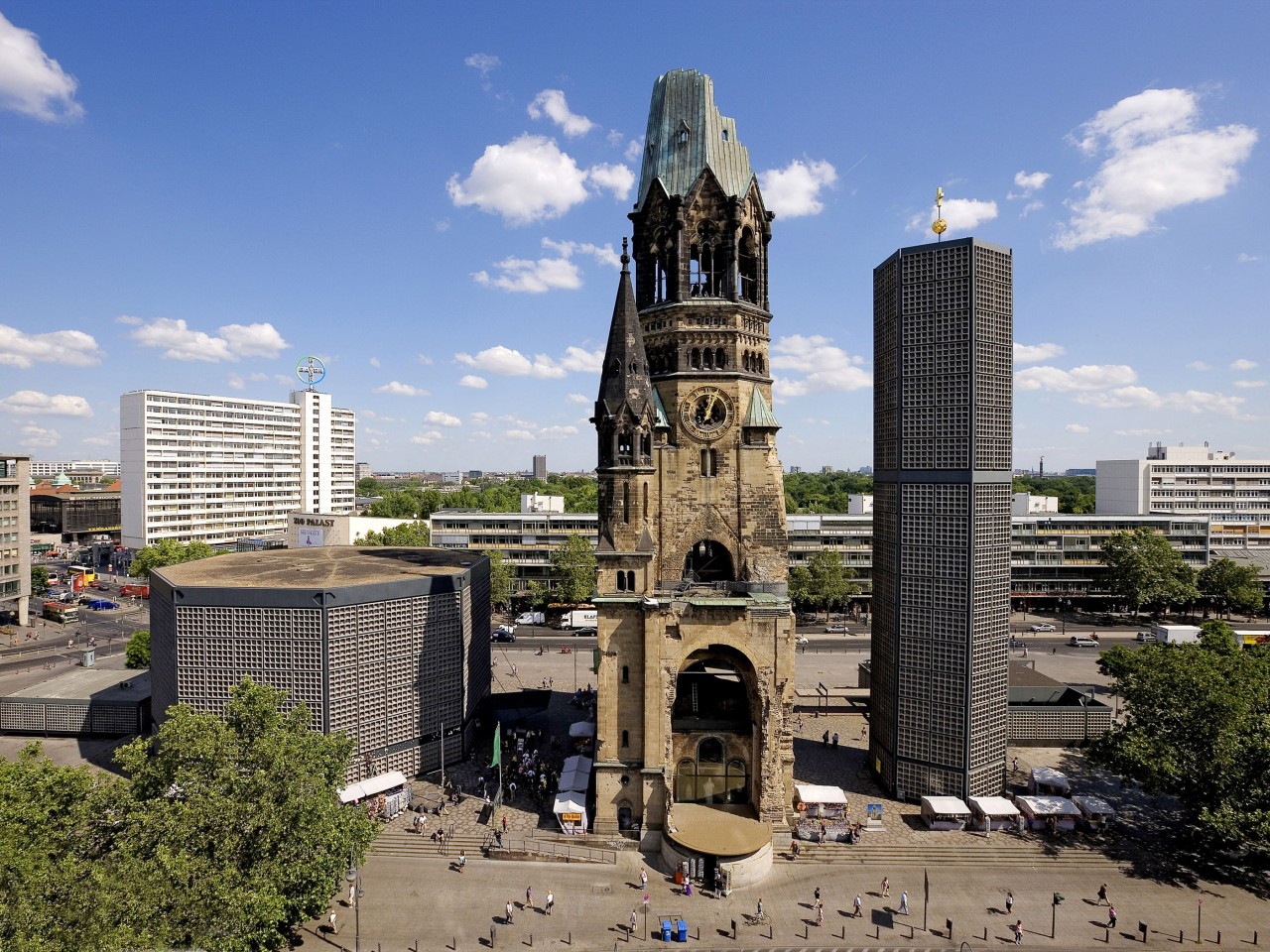The Protestant Kaiser Wilhelm Memorial Church (in German: Kaiser-Wilhelm-Gedächtniskirche, but mostly just known as Gedächtniskirche [ɡəˈdɛçtnɪsˈkɪʁçə]) is located in Berlin on the Kurfürstendamm in the centre of the Breitscheidplatz.
The original church on the site was built in the 1890s. It was badly damaged in a bombing raid in 1943. The present building, which consists of a church with an attached foyer and a separate belfry with an attached chapel, was built between 1959 and 1963. The damaged spire of the old church has been retained and its ground floor has been made into a memorial hall.
The Memorial Church today is a famous landmark of western Berlin, and is nicknamed by Berliners "der Hohle Zahn", meaning "The Hollow Tooth".
Old church
Kaiser Wilhelm II decided to name the church in honor of his grandfather Kaiser Wilhelm I. The foundation stone was laid on March 22, 1891, which was Wilhelm I's birthday. The competition for the design was won by Franz Schwechten who planned for a large church to be built in Romanesque Revival style, including 2,740 square metres (29,500 sq ft) of wall mosaic. The spire was 113 metres (371 ft) high and the nave seated over 2,000 people. The church was consecrated on September 1, 1895. By this time of the consecration the entrance hall in the lower section had not been completed. This was opened and consecrated on February 22, 1906. In the Second World War, on the night of November 23, 1943, the church was irreparably damaged in an air raid. The church was largely destroyed but part of the spire and much of the entrance hall survived. Currently the remains of the church are being renovated with a scheduled completion in late summer 2013.
New church
This was designed by Egon Eiermann and consists of four buildings grouped around the remaining ruins of the old church. The initial design included the demolition of the spire of the old church but following pressure from the public, it was decided to incorporate it into the new design. The four buildings comprise, on the west of the ruins, the new church with a foyer to its west, and to the east of the ruins, a tower with a chapel to its northeast. The plan of the church is octagonal while the plan of the tower is hexagonal. These components are sited on a plateau measuring 100 metres long and 40 metres wide. The new buildings are constructed of concrete, steel and glass. The walls of the church are made of a concrete honeycomb containing 21,292 stained glass inlays. The glass, designed by Gabriel Loire, was inspired by the colours of the glass in Chartres Cathedral. The predominant colour is blue, with small areas of ruby red, emerald green and yellow. The church is 35 metres in diameter and 20.5 metres high with a capacity of over 1,000. Because of the distinctive appearance of the new buildings, it is sometimes nicknamed "Lippenstift und Puderdose” (the lipstick and the powder box) by Berliners.
Inside the church, opposite the entrance, is a figure of Christ which is suspended above the altar. This is made from tombak and was designed by Karl Hemmeter. The cross on the altar, by Peter Tauchnitz, is of gilt silver with 37 rock crystals. To the left of the altar is the baptismal font on a stand filled with Carrara marble which contains a majolica bowl for the holy water. To the right of the altar is an octagonal pulpit. Opposite the altar on a gallery is an organ containing about 5,000 pipes, which was built by Schuke. Plexiglas panels have been installed over the organ gallery to improve the acoustics. By the northeast wall of the church are three works of art. The first is a bronze plaque commemorating the Protestant martyrs who died during the Nazi regime between 1933 and 1945. It incorporates a Spanish wooden crucifix dating from the 13th century. The plaque was placed in the church on 20 July 1964, the 20th anniversary of an attempt to assassinate Hitler. Next to this is the Stalingrad Madonna, a symbol of hope and reconciliation. This is a charcoal drawing made by Kurt Reuber during the time he was trapped inside Stalingrad at Christmas 1942. Copies of this drawing have been sent to Coventry Cathedral and the Russian Orthodox Church in Stalingrad (now Volgograd). The third item of art is an icon of the Virgin Mary from Volgograd.
The tower is 12 metres in diameter and 53.5 metres high with a flat roof. Atop the tower is a pole carrying a gilded sphere above which is a gilded cross. It contains a belfry with six bronze bells cast from French cannon, booty from the Franco-Prussian War of 1870–71. The foundation stone of the new church was laid on 9 May 1959, its roofing ceremony was carried out on 16 December 1960, the new bells were consecrated on 19 July 1961, the new church was consecrated on 17 December 1961 and the foyer and chapel were completed in December 1963.
Spire and memorial hall
The entrance hall in the base of the damaged spire was reopened to visitors, having been consecrated on 7 January 1987. Its floor contains a mosaic of the Archangel Michael fighting the dragon. The vault shows a procession of Hohenzollern princes, early and more recent. Other mosaics show important monarchs in medieval Germany, Reformation thinkers and Reformation princes. Bas-relief sculptures illustrate scenes from biblical stories, scenes from the life of Kaiser Wilhelm I and symbolic figures representing war and peace. In the north apse are 16 display panels which tell the story of the old church and its destruction. At the opposite end of the hall are three items which symbolise the history of the church. In the middle is a damaged statue of Christ which originally stood on the altar of the old church. To its right is the Cross of Nails which was made from nails in the roof timbers of Coventry Cathedral. This cathedral had been severely damaged in a German air raid on 14 November 1940. To the left of the statue of Christ is an icon cross which was given by the Russian Orthodox Church and handed over in 1988. Outside the hall are four sandstone figures made by Stefan Kaehne.
In December 2007, Charles Jeffrey Gray, a former British pilot who carried out World War II bombing raids over Germany, joined a campaign to rescue the Kaiser Wilhelm Memorial Church from decay. After reading about the condition of the Church, Gray contacted Wolfgang Kuhla, the chairman of the church's advisory board, urging that its tower be restored. In response, a fund was launched to help raise the costs of its repair.




